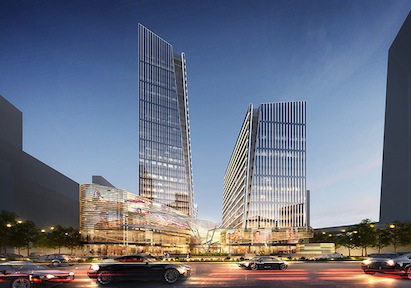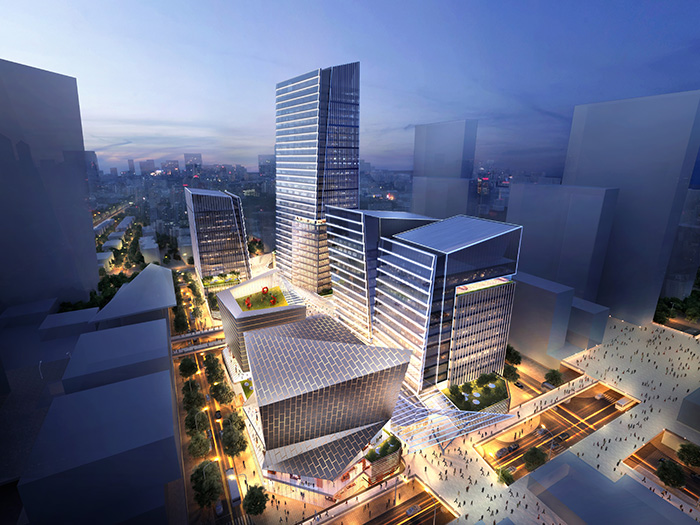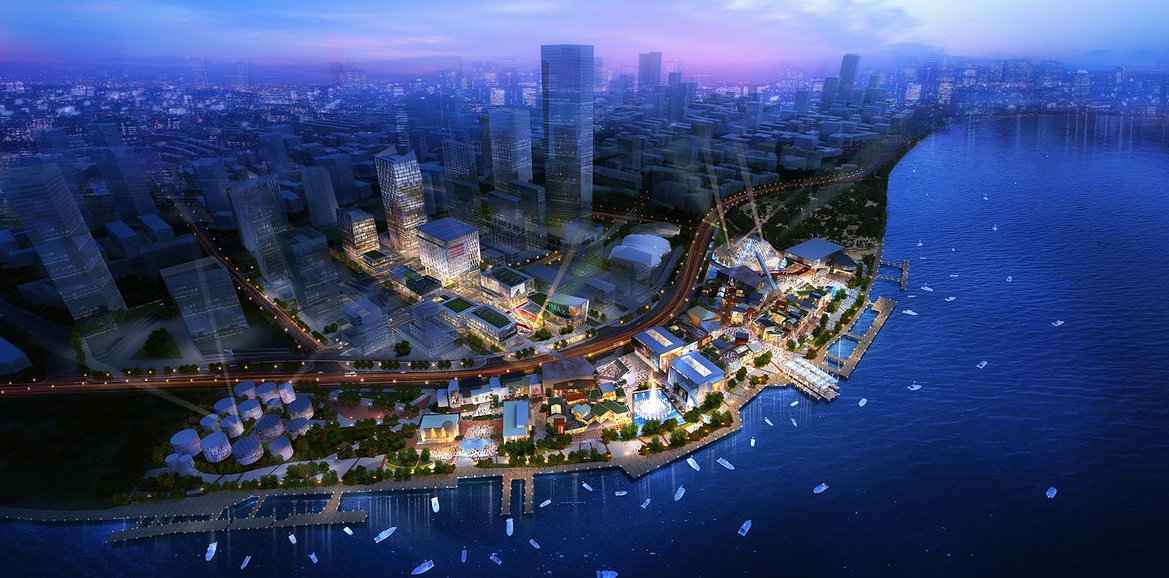International architecture firm Kohn Pedersen Fox Associates (KPF) is pleased to unveil designs for DreamWorks Asia Headquarters, Oriental Dreamworks and creative offices in the new Shanghai DreamCenter, which constitutes one of the most exciting projects in China.
Located along the riverside in Xuhui District, the 463,000-square-meter DreamCenter is an integrated cultural and lifestyle landmark that will feature performing arts spaces, creative media spaces, black box and imax theaters, as well as world-class entertainment, fashionable retail areas and premium restaurants and bars.
“Together with the West Bund Media Port, this will become the world’s third great urban center for entertainment and arts alongside New York’s Broadway and London’s West End,” said DreamWorks Animation CEO Jeffrey Katzenberg. With offices on New York’s 42nd Street and in London’s Covent Garden, KPF is quite literally ‘in’ show business and has come to know what makes such creative capitals tick. In the words of KPF Principal Paul Katz, “We also know first-hand the value of locating in such creative cores, for our process, our staff, and our work as architects.”
A collaboration between Hong Kong Lan Kwai Fong Group, DreamWorks Animation and Shanghai China Media Capital, the DreamCenter is the flagship project of Shanghai’s West Bund Media Port, a large-scale development focused on creative and digital media, technology, and cultural industries.
Katz commented, “We’ve watched Shanghai develop into a global city. And now, three visionaries, three of the most influential shapers of global culture in the 21st century are coming together to create its creative hub: Jeffrey Katzenberg, who heads one of the most influential studios in the industry; Allan Zeman, who has made such a huge contribution to Hong Kong, including the development of Lan Kwai Fong in HK and now China, which transformed the culture of public space and demonstrated a new respect for international lifestyle and world-class entertainment; and Li Ruigang, the visionary who has punctuated the evolution of China’s media and entertainment industry. In 20 years, Shanghai has transformed itself from an agrarian-based economy to one of the leading post-industrial economies in Asia. The DreamCenter project will further define Shanghai’s role as a global meeting-place for creative industry, technology, entertainment, and culture.”
Through the revitalization of the hundred-year-old former cement factory and other industrial artifacts into iconic creative live performance venues and F&B facilities, DreamCenter blends together the site’s industrial and cultural history with modern architecture, offering an unseen experience for the people of Shanghai and international tourists.
KPF’s two-block design represents the creative heart of the master plan—and its largest district. The eastern block is home to a pair of creative office towers, a theater building and arts building, whose open-air rooftop features a sculpture garden. The western block features a pair of towers (DreamCenter’s tallest), which angle slightly as they rise above this space, framing the views westward towards the DreamCenter and Huangpu Riverfront and creating “sky canyons” that capture the sky by day and emanate light and activity by night. At the base of the tower, the design includes a direct connection to the Shanghai Metro, a shared retail podium, and an elevated pedestrian walkway lined with shops and restaurants that extends eastward to connect the entire development.
Like KPF’s designs for Roppongi Hills in Tokyo, Hudson Yards in New York, and Covent Garden in London, Shanghai DreamCenter will become the great gathering place for the city, bringing together diverse activities, industries, and cultures, and enabling this energy and streetlife to radiate outwards, activating the city.
Construction of the Shanghai DreamCenter will begin this year and is expected to complete in 2017.
About Kohn Pedersen Fox Associates (KPF)
Kohn Pedersen Fox Associates (KPF) is one of the world’s pre-eminent architecture firms, providing architecture, interior, programming and masterplanning services for clients in both the public and private sectors. Operating as one firm with six global offices, KPF is led by 24 Principals and 27 Directors. The firm’s 600+ staff members come from 43 different countries, speak more than 30 languages and include over 80 LEED accredited professionals.
KPF’s diverse portfolio, which features over 70 projects certified or pursuing green building certification, comprises corporate, hospitality, residential, academic, civic, transportation and mixed-use projects located in more than 35 countries. The firm’s recent work includes the Abu Dhabi International Airport, the Shanghai World Financial Center, the International Commerce Centre in Hong Kong, New Songdo City in Korea, the Mandarin Oriental Las Vegas, the RBC Centre and Ritz? Carlton in Toronto, and Heron Tower, Sixty London and Unilever House in London.
Related Stories
| Nov 15, 2010
Gilbane to acquire W.G. Mills, Inc.
Rhode Island-based Gilbane Building Company announced plans to acquire W.G. Mills, Inc., a construction management firm with operations based in Florida. The acquisition will dramatically strengthen Gilbane’s position in Florida’s growing market and complement its already established presence in the southeast.
| Nov 11, 2010
Saint-Gobain to make $80 million investment in SAGE Electrochromics
Saint-Gobain, one of the world’s largest glass and construction material manufacturers, is making a strategic equity investment in SAGE Electrochromics to make electronically tintable “dynamic glass” an affordable, mass-market product, ushering in a new era of energy-saving buildings.
| Nov 11, 2010
Saint-Gobain to make $80 million investment in SAGE Electrochromics
Saint-Gobain, one of the world’s largest glass and construction material manufacturers, is making a strategic equity investment in SAGE Electrochromics to make electronically tintable “dynamic glass” an affordable, mass-market product, ushering in a new era of energy-saving buildings.
| Nov 11, 2010
USGBC certifies more than 1 billion square feet of commercial space
This month, the total footprint of commercial projects certified under the U.S. Green Building Council’s LEED Green Building Rating System surpassed one billion square feet. Another six billion square feet of projects are registered and currently working toward LEED certification around the world. Since 2000, more than 36,000 commercial projects and 38,000 single-family homes have participated in LEED.
| Nov 10, 2010
$700 million plan to restore the National Mall
The National Mall—known as America’s front yard—is being targeted for a massive rehab and restoration that could cost as much as $700 million (it’s estimated that the Mall has $400 million in deferred maintenance alone). A few of the proposed projects: refurbishing the Grant Memorial, replacing the Capitol Reflecting Pool with a smaller pool or fountain, reconstructing the Constitution Gardens lake and constructing a multipurpose visitor center, and replacing the Sylvan Theater near the Washington Monument with a new multipurpose facility.
| Nov 9, 2010
Just how green is that college campus?
The College Sustainability Report Card 2011 evaluated colleges and universities in the U.S. and Canada with the 300 largest endowments—plus 22 others that asked to be included in the GreenReportCard.org study—on nine categories, including climate change, energy use, green building, and investment priorities. More than half (56%) earned a B or better, but 6% got a D. Can you guess which is the greenest of these: UC San Diego, Dickinson College, University of Calgary, and Dartmouth? Hint: The Red Devil has turned green.
| Nov 9, 2010
12 incredible objects being made with 3D printers today
BD+C has reported on how 3D printers are attracting the attention of AEC firms. Now you can see how other creative types are utilizing this fascinating printing technology. Among the printed items: King Tut’s remains, designer shoes, and the world’s smallest Rubik’s Cube.
| Nov 9, 2010
U.S. Army steps up requirements for greening building
Cool roofs, solar water heating, and advanced metering are among energy-efficiency elements that will have to be used in new permanent Army buildings in the U.S. and abroad starting in FY 2013. Designs for new construction and major renovations will incorporate sustainable design and development principles contained in ASHRAE 189.1.













